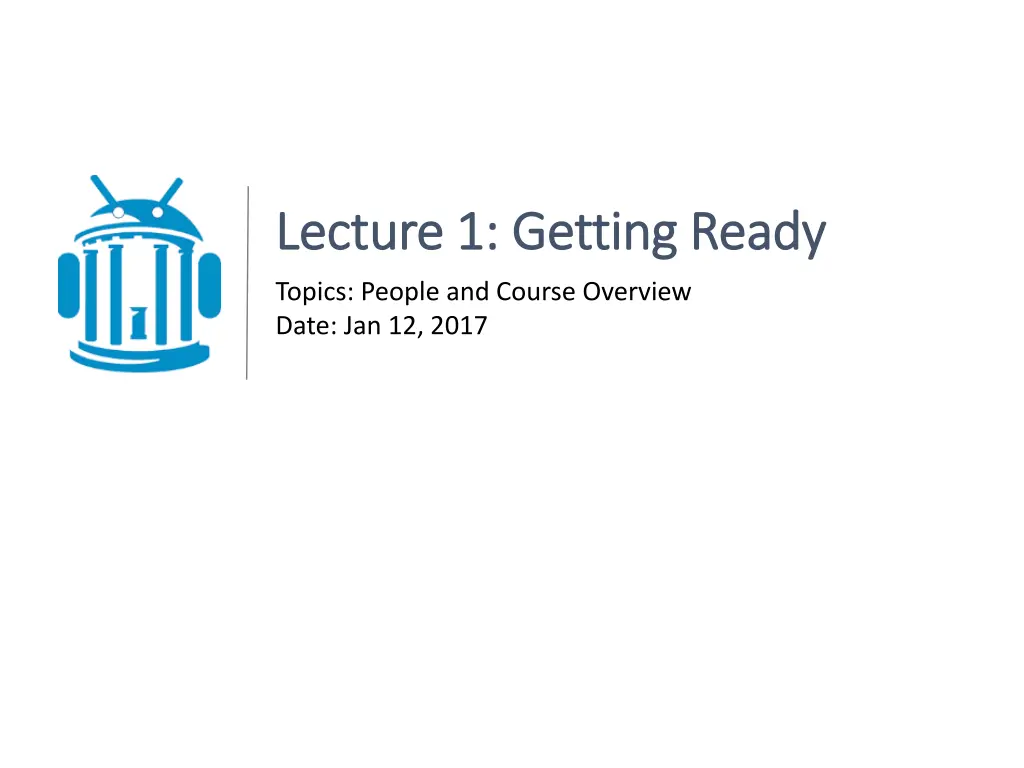
Exploring Mobile Computing Systems and Smart Technology
Dive into the world of mobile computing systems and smart technology in this informative course overview. Get insights on course topics, grading structure, cool projects, and the functionalities of smart mobile systems. Discover the impact of innovative projects like Breadcrumbs, Balance Buddy, and Roybot in the realm of mobile technology. Understand the significance of sensors in smart devices and how they enhance user experiences in portable electronic devices.
Download Presentation

Please find below an Image/Link to download the presentation.
The content on the website is provided AS IS for your information and personal use only. It may not be sold, licensed, or shared on other websites without obtaining consent from the author. If you encounter any issues during the download, it is possible that the publisher has removed the file from their server.
You are allowed to download the files provided on this website for personal or commercial use, subject to the condition that they are used lawfully. All files are the property of their respective owners.
The content on the website is provided AS IS for your information and personal use only. It may not be sold, licensed, or shared on other websites without obtaining consent from the author.
E N D
Presentation Transcript
Lecture 1: Getting Ready Lecture 1: Getting Ready Topics: People and Course Overview Date: Jan 12, 2017
About the course About the course T TH, 3:30 pm 4:45 pm, SN 014 Course page: http://mobile.web.unc.edu/ oLectures (slides are uploaded after the class) oLabs (may have pre-lab activities) oAssignment Total 4 (uploaded 2 wks before deadline) oQuiz Total 4 (only undergrads) oPresentation (grads, will discuss over email) oProject (grads research type, ugrads cool apps) (More on Exams and Projects as they approach)
Grading Grading oClass Participation (5%) oProgramming Assignments (60%) oQuiz or Presentation (15%) oProject (20%)
Spring 2016 Spring 2016 Cool Projects (2) Cool Projects (2) Project: Breadcrumbs https://youtu.be/tk1i-oG2XBc
Spring 2016 Spring 2016 Cool Projects (2) Cool Projects (2) Project: Balance Buddy https://youtu.be/BlBHEA4baOc
Spring 2016 Spring 2016 Cool Projects (3) Cool Projects (3) Project: Roybot https://youtu.be/tOAKM8Fr5U0
Mobile Computing Systems Mobile Computing Systems A portable electronic device along with its communication infrastructure, that enables computation and wireless communication.
Smart * Smart * Smart mobile systems contain a mobile OS that can run mobile Apps.
Smart+ * Smart+ * Smart mobile systems often contain a touch screen, built-in GPS receiver, sensors, in addition to what a standard computer has. Example of phone sensors: oAccelerometer oMagnetometer oGyroscope oCompass oLight oProximity oTemperature oPressure
Comparison Comparison Device Processor Mem Storage Connectivity Laptop (Macbook Pro) 2.80 GHz 16 GB 512 GB WiFi Smartphone (Nexus 6P) 1.55 GHz 3 GB 128 GB WiFi, Cellular, BLE, NFC Wearables (Gear S) 1 GHz 512 MB 4 GB WiFi, BLE, NFC http://www.gsmarena.com/
Comparison: Communication Comparison: Communication Network Type Speed Range Power Common Use WLAN 600 Mbps 45 m 90 m 100 mW Internet. LTE 5-12 Mbps 35km 120 300 mW Mobile Internet 3G 2 Mbps 35km 3 mW Mobile Internet Bluetooth 1 3 Mbps 100 m 1 W Headsets, audio streaming. Bluetooth LE 1 Mbps 100+ m .01 .5 W Wearables, fitness. (The numbers are not that simple to estimate exactly, but should give you an idea) http://dl.acm.org/citation.cfm?id=1644927 http://dl.acm.org/citation.cfm?id=2307658 http://ieeexplore.ieee.org/xpls/abs_all.jsp?arnumber=6616827&tag=1
Putting them together Putting them together We will learn how to develop a mobile system consisting of sensors, mobile devices, and laptop computers who will talk to each other over BLE and WiFi, as appropriate!
Course Lecture Topics Course Lecture Topics Android App Development Android Source Building/Customization Arduino Programming Device Architecture Mobile Networks Remote Services Some Research Papers
Two Example Systems Two Example Systems Android Based System (MobiCOG) Arduino Based System (Typing Ring)
Android Example: Android Example: MobiCOG MobiCOG Automation of MiniCog a paper based 3 minute dementia pre-screening test.
Video Demo Video Demo MobiCOG MobiCOG https://www.youtube.com/watch?v=kk05dKghpCA
Android Example: Android Example: MobiCOG MobiCOG Features: oChain Codes oSymmetry Classifier: ok-NN 1 Chain-Code = (0,2,0,3,1,1,3,0) Symmetry = (80%, 70%) 17
Arduino Example: Typing Ring Arduino Example: Typing Ring A Wearable, portable, accessory that allows us to input text into computers of different forms. Connects wirelessly as a standard Bluetooth Smart keyboard. Works on surfaces such as a table , a wall, or even your lap. Over 98% accurate in detecting typed keys. Yields a typing speed of up to 50 keys/min. Yields up to 15,500 keys with full charge. Weighs ~ 15 gm
Arduino Example: Typing Ring Arduino Example: Typing Ring Wearing It The ring is worn in the middle finger. Seeking 3-Letter Zones As the user hovers his hand on a surface, 3-consecutive keys on a on-screen keyboard is highlighted. On-screen visual feedback Typing a Key The User makes a typing gesture with one of three fingers and the corresponding key is typed in. Typing with 3-fingers
Video Demo Video Demo 20
Next Class: Lab 1 Next Class: Lab 1 The goal is to make sure everyone is ready with their Android development environment. Android Studio http://developer.android.com/sdk/installing/index.html Will upload the pdf: Prelab: Android Studio Setup.
